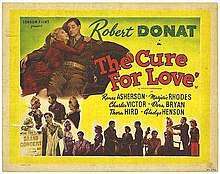The Cure for Love
The Cure for Love is a 1949 British comedy film starring and directed by Robert Donat. The cast also includes Renee Asherson and Dora Bryan. The film was based on a hit play of the same name by Walter Greenwood about a mild-mannered soldier returning home after the Second World War.
| The Cure for Love | |
|---|---|
 | |
| Directed by | Robert Donat |
| Produced by | Robert Donat |
| Written by | Walter Greenwood (play) Albert Fennell Alexander Shaw Robert Donat |
| Starring | Robert Donat Renee Asherson Dora Bryan |
| Music by | William Alwyn |
| Cinematography | Jack E. Cox |
| Edited by | Bert Bates |
Production company | |
| Distributed by | British Lion Films |
Release date | 29 December 1949 (London premiere) 6 February 1950 (UK general release) |
Running time | 98 minutes |
| Country | United Kingdom |
| Language | English |
| Box office | £193,781 (UK)[1] |
Production
Donat had appeared in the stage play in 1945.[2] In 1948 it was announced he would make a film version for Alexander Korda.[3] It was his sole feature credit as director, although he had directed on stage.
Francis Wignall was chosen out of 3,000 boys to play a lead role.[4] Donat battled ill health during pre-production.[5] The production was shot at Shepperton Studios, with sets designed by the art director Wilfred Shingleton.
Reception
Trade papers called the film a "notable box office attraction" in British cinemas in 1950.[6] According to Kinematograph Weekly the 'biggest winners' at the box office in 1950 Britain were The Blue Lamp, The Happiest Days of Your Life, Annie Get Your Gun, The Wooden Horse, Treasure Island and Odette, with "runners up" being Stage Fright, White Heat, They Were Not Divided, Trio, Morning Departure, Destination Moon, Sands of Iwo Jima, Little Women, The Forsythe Saga, Father of the Bride, Neptune's Daughter, The Dancing Years, The Red Light, Rogues of Sherwood Forest, Fancy Pants, Copper Canyon, State Secret, The Cure for Love, My Foolish Heart, Stromboli, Cheaper by the Dozen, Pinky, Three Came Home, Broken Arrow and Black Rose.[7]
Cast
- Robert Donat as Sergeant Jack Hardacre
- Renée Asherson as Milly Southern
- Marjorie Rhodes as Mrs. Sarah Hardacre
- Charles Victor as Henry Lancaster
- Thora Hird as Mrs. Dorbell
- Dora Bryan as Jenny Jenkins
- Gladys Henson as Mrs. Jenkins
- John Stratton as Sam
- Francis Wignall as Claude
- Norman Partridge as Vicar
- Edna Morris as Mrs. Harrison
- Michael Dear as Albert
- Tonie MacMillan as Mrs. Donald
- Lilian Stanley as Mrs. Small
- Margot Bryant as Mrs. Hooley
- Lucille Gray as Tough girl
- Jack Howarth as Hunter
- Sam Kydd as Charlie Fox
- Jack Rodney as Eddie
- Reginald Green as Douglas
- Johnny Catcher as Canadian soldier
- Jan Conrad as Polish soldier
- Raymond Rollett as The Singer
References
- Vincent Porter, 'The Robert Clark Account', Historical Journal of Film, Radio and Television, Vol 20 No 4, 2000 p489
- "Gordon Gilmour's LONDON DIARY". The Sun (11, 072). Sydney. 17 July 1945. p. 6 (LATE FINAL EXTRA). Retrieved 27 March 2017 – via National Library of Australia.
- "LATEST FILM NEWS FROM ABROAD". The Sun (11, 912). Sydney. 1 April 1948. p. 17 (LATE FINAL EXTRA). Retrieved 27 March 2017 – via National Library of Australia.
- "STARRY WAY". The Courier-Mail (3889). Brisbane. 14 May 1949. p. 2. Retrieved 27 March 2017 – via National Library of Australia.
- "Hardest-workes man in British films is Donat". The Australian Women's Weekly. 17 (17). 1 October 1949. p. 44. Retrieved 27 March 2017 – via National Library of Australia.
- Robert Murphy, Realism and Tinsel: Cinema and Society in Britain 1939-48 2003 p212
- Lant, Antonia (1991). Blackout : reinventing women for wartime British cinema. Princeton University Press. p. 233.